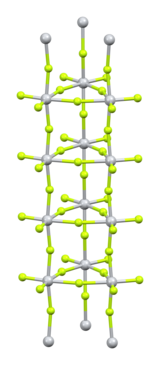Titanium tetrafluoride

| |
| Names | |
|---|---|
| IUPAC name
Titanium(IV) fluoride
| |
| Other names
Titanium tetrafluoride
| |
| Identifiers | |
3D model (JSmol)
|
|
| ChemSpider | |
| ECHA InfoCard | 100.029.106 |
| EC Number |
|
PubChem CID
|
|
| UNII | |
CompTox Dashboard (EPA)
|
|
| |
| |
| Properties | |
| TiF4 | |
| Molar mass | 123.861 g/mol |
| Appearance | white powder |
| Density | 2.798 g/cm3 |
| Melting point | 377 °C (711 °F; 650 K) |
| Boiling point | sublimes |
| Hazards | |
| GHS labelling:[1] | |
 
| |
| Danger | |
| H302, H312, H314, H332 | |
| P260, P261, P264, P270, P271, P280, P301+P312, P301+P330+P331, P302+P352, P303+P361+P353, P304+P312, P304+P340, P305+P351+P338, P310, P312, P322, P330, P363, P405 | |
| NFPA 704 (fire diamond) | |
| Related compounds | |
Other anions
|
Titanium(IV) bromide Titanium(IV) chloride Titanium(IV) iodide |
Related compounds
|
Titanium(III) fluoride |
Except where otherwise noted, data are given for materials in their standard state (at 25 °C [77 °F], 100 kPa).
| |
Titanium(IV) fluoride is the inorganic compound with the formula TiF4. It is a white hygroscopic solid. In contrast to the other tetrahalides of titanium, it adopts a polymeric structure.[2] In common with the other tetrahalides, TiF4 is a strong Lewis acid.
Preparation and structure
[edit]The traditional method involves treatment of titanium tetrachloride with excess hydrogen fluoride:[3]
- TiCl4 + 4 HF → TiF4 + 4 HCl
Purification is by sublimation, which involves reversible cracking of the polymeric structure.[4] X-ray crystallography reveals that the Ti centres are octahedral, but conjoined in an unusual columnar structure.[5]
Reactions
[edit]
TiF4 forms adducts with many ligands. One example is the complex cis-TiF4(CH3CN)2, which is formed by treatment with acetonitrile.[6] It is also used as a reagent in the preparation of organofluorine compounds.[7] With fluoride, the cluster [Ti4F18]2- forms. It has an adamantane-like Ti4F6 core.[8]
Related to its Lewis acidity, TiF4 forms a variety of hexafluorides also called hexafluorotitanates. Hexafluorotitanic acid has been used commercially to clean metal surfaces. These salts are stable at pH<4 in the presence of hydrogen fluoride, otherwise they hydrolyze to give oxides.[3]
References
[edit]- ^ "Titanium tetrafluoride". pubchem.ncbi.nlm.nih.gov. Retrieved 12 December 2021.
- ^ Greenwood, Norman N.; Earnshaw, Alan (1997). Chemistry of the Elements (2nd ed.). Butterworth-Heinemann. ISBN 978-0-08-037941-8.
- ^ a b Meshri, Dayal T. (2000). "Fluorine Compounds, Inorganic, Titanium". Kirk-Othmer Encyclopedia of Chemical Technology. doi:10.1002/0471238961.2009200113051908.a01. ISBN 978-0-471-48494-3.
- ^ Handbook of Preparative Inorganic Chemistry, 2nd Ed. Edited by G. Brauer, Academic Press, 1963, NY. Vol. 1. p. 200.
- ^ Bialowons, H.; Mueller, M.; Mueller, B.G. (1995). "Titantetrafluorid - Eine Überraschend einfache Kolumnarstruktur". Zeitschrift für Anorganische und Allgemeine Chemie. 621 (7): 1227–1231. doi:10.1002/zaac.19956210720.
- ^ Nikiforov, Grigory B.; Roesky, Herbert W.; Koley, Debasis (2014). "A survey of Titanium Fluoride Complexes, Their Preparation, Reactivity, and Applications". Coordination Chemistry Reviews. 258–259: 16–57. doi:10.1016/j.ccr.2013.09.002.
- ^ Blizzard, T. A.; Sikervar, Vikas (2014). "Titanium(IV) Fluoride". Encyclopedia of Reagents for Organic Synthesis. pp. 1–5. doi:10.1002/047084289X.rn00123.pub2. ISBN 978-0-470-84289-8.
- ^ Mazej, Zoran; Goreshnik, Evgeny (2009). "Poly[perfluorotitanate(IV)] Salts of [H3O]+, Cs+, [Me4N]+, and [Ph4P]+ and about the Existence of an Isolated [Ti2F9]− Anion in the Solid State". Inorganic Chemistry. 48 (14): 6918–6923. doi:10.1021/ic9009338. PMID 19545141.

